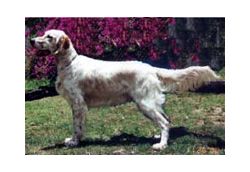English Setter Dog Breed
Aliases: Laverack Setter, Llewellyn Setter
Description
The English Setter was bred for elegance. The dogs are lean, with powerful chests sloping back to the smooth, tense lines of legs and feet, the ready tail, and the powerful muscles. An extra splash of feathering on the Setter\'s smooth coat and a distinctive "belton" bi-colored (or tri-colored coat) just adds an extra touch of visibility and an extra touch of class to these already aristocratic, sleek, and intelligent dogs.
Dog breeders for years have known this--and the Setter\'s habitual prey knows it as well. The Setter\'s hunting method entirely depends on its visibility and its powerful bearing--the Setter was bred to stalk its prey through heavy undergrowth, to mesmerize it with its "hypnotic" eyes and elegant appearance, and then to make itself visible to its master so that the hunt could be successful. Thus the Setter has been bred for intelligence as well as elegance, making the dog both beautiful and capable of acting independently in order to achieve its goals.
Coat Description
The English Setter\'s coat is flat, straight, and medium-length, which makes the structure of the dog\'s underlying gaunt body visible. The coat is feathered at various points, most prominently at the ears, tail, and legs.
History
The tradition of "setting" dogs began with a single type of Spanish Spaniel at some point in the 1300s (according to written records of the time.) The Spanish Spaniel would track birds through the undergrowth, find them, and then lie down in a "pointing" position, allowing the hunter to throw a large net over the area (including the dog itself!) in order to trap flushed birds on their attempt to escape.
However, as useful as a net is for hunting purposes, a rifled gun is more useful still--and the old Spaniel "pointers" were becoming quickly obsolete as gun hunting became more common in the early 19th century. Thanks to the efforts of two gentleman breeders--Laverack and Llewellyn, who lend their names to the two variants of the general English Setter--the modern upright setter was created through selective breeding. The Laverack Setter was created more for attractiveness and genetic purity, making the Laverack variant of the English Setter breed more common in show rings, while the Llewellyn Setter was created more for simple hunting efficiency and power, making the Llewellyn variant of the English Setter more common in the open country, staring down a fat grouse and waiting for his master to arrive with the rifle and the reward.
Temperament
The English Setter is an energetic, outdoorsy dog whose greatest joy is simply to expend its energy. Any Setter owner will need to have a large, fenced yard (or other adequate outdoor space) and the willingness to spend hours every day walking, jogging with, and otherwise exercising the English Setter. Enough exercise outdoors will help to keep the Setter calm and relaxed indoors--which is good, since the Setter\'s native companionableness make it an ideal indoor pet (if you can keep up with the grooming.)
This native companionableness may seem surprising, considering the Setter\'s independent hunting style. But the Setter is one of the more friendly and needy dogs out there when it comes to human beings. English Setters can\'t be left alone for too long without becoming destructive, and any withdrawal of affection--including harsh language--can seriously upset the English Setter. If affection is given, though, the English Setter can be a funny, energetic, and engaging companion, noted for its "clownish" demeanor.
Setters are extremely good with children. They are not quite so good with other animals, and old hunting instincts can sometimes take over. It\'s important to train your Setter early in order to socialize it to other household pets, and to help make your Setter more manageable during outdoor exercise.
Thyroid Disease - Very High Risk
The English Setter ranks #1 among all breeds for autoimmune thyroiditis prevalence. There is a high risk of obtaining a dog that will develop thyroid disease. For this reason you should make sure you, or your breeder, are testing all dogs before breeding. It may even be a good idea to test dogs that you don't plan on breeding so that any instance of disease can be traced back to breeding pairs and eliminated.
| Rank Among Breeds |
Number of Dogs Tested |
Percent of Dogs With Disease |
| #1 |
1457 |
31.4% |
You can download the full report (on all breeds) by the Michigan State University Diagnostic Center for Population and Animal Health. Here
Other Health Problems
The English Setter can be affected by a number of health problems, including:
- Hip Dysplasia (common in larger breeds of dog; avoid strenuous exercise early in life and see a veterinarian regularly)
- Elbow Dysplasia
- Congenital deafness (puppies can be tested for this at about five weeks of age)
In addition, all members of the breed are susceptible to certain cancers and skin diseases. Most of these ailments are genetic, and selecting an English Setter puppy carefully from reliable breeders (or another reliable source) will sharply minimize the risk for your dog.

